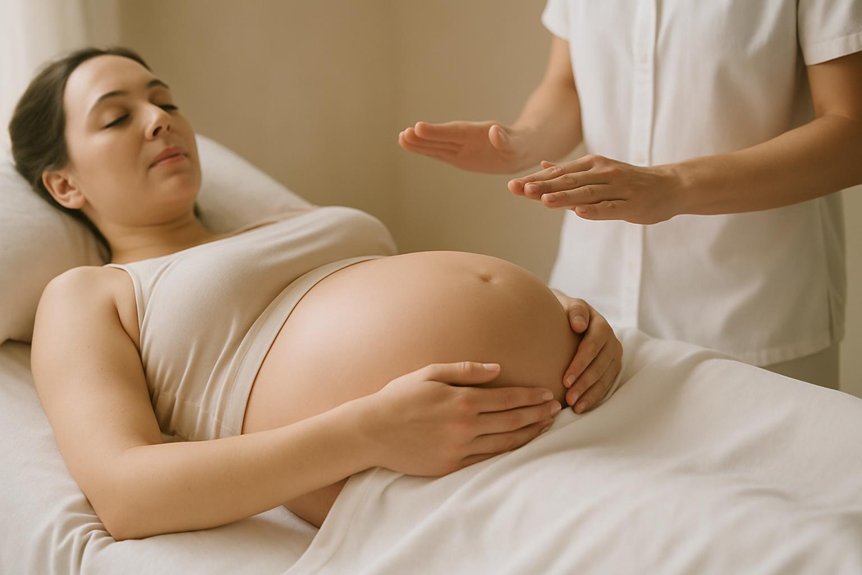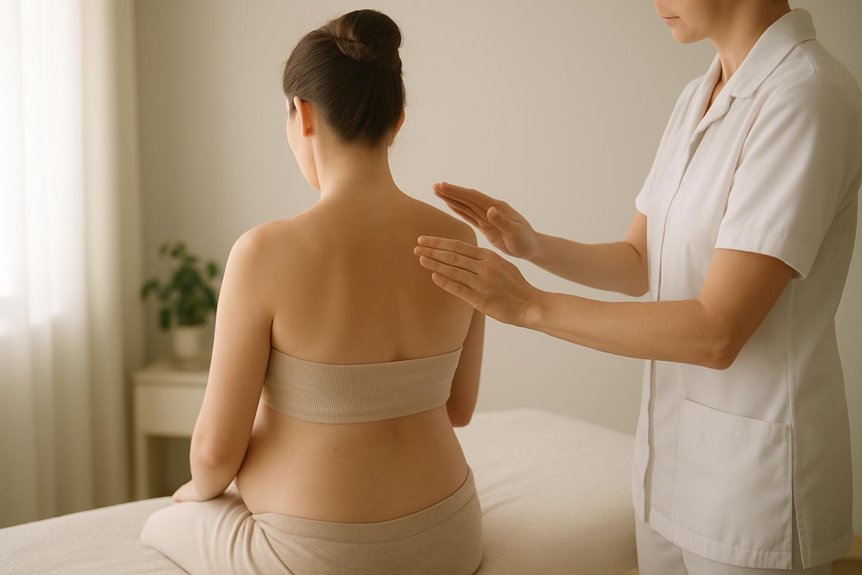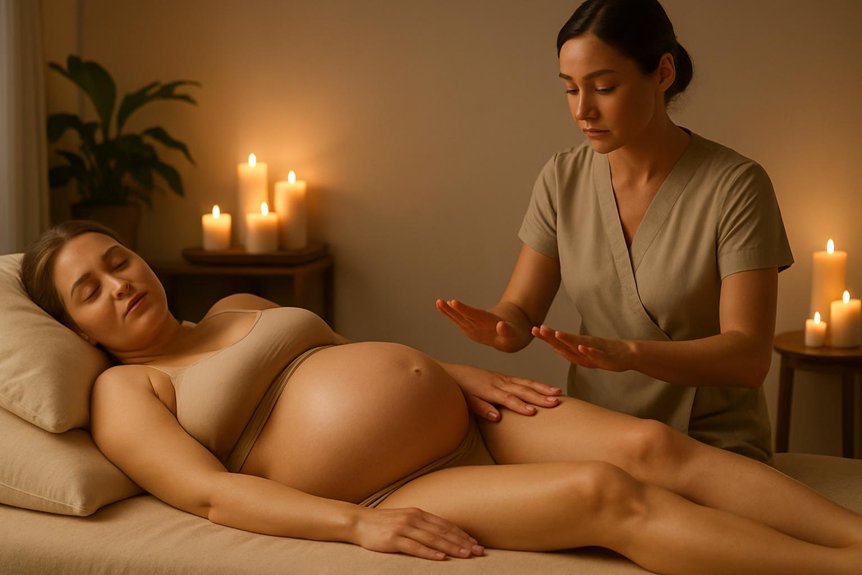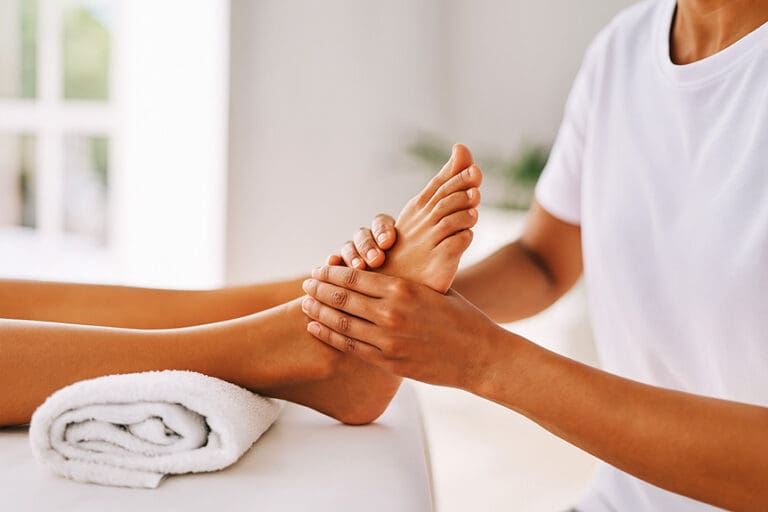During pregnancy, massage therapists avoid the abdomen, lower belly, and breasts due to heightened sensitivity and potential for discomfort or uterine stimulation. Deep pressure is contraindicated over reflex zones around the ankles and wrists, as well as the neck, throat, and between the shoulder blades, to prevent adverse vascular or neurological responses. The lower back, sacrum, and chest should also be approached cautiously. Extensive guidance is available for those seeking additional information on safe practice.
The Abdomen and Lower Belly

During pregnancy, the abdomen and lower belly constitute sensitive anatomical regions that require special consideration during massage therapy. Direct pressure or manipulation of these areas is generally contraindicated, particularly during the first trimester, due to the potential for disrupting delicate physiological changes.
At Spa & Massage, therapists are trained to avoid these regions, prioritizing both maternal and fetal well-being. Gentle, superficial strokes may be considered in later trimesters but are performed only with explicit consent and clinical justification. The uterus becomes more vascular and sensitive, and any deep or targeted work risks discomfort or stimulation of uterine contractions.
Clients are encouraged to communicate openly about sensations and boundaries, ensuring trust and safety remain central to the therapeutic experience. This protective approach reflects evidence-based standards in pregnancy massage. Additionally, reflexology offers a healing power that can benefit expectant mothers by focusing on safe, non-abdominal pressure points, further supporting maternal comfort and relaxation.
The Ankles and Feet
Why are the ankles and feet areas of particular caution in prenatal massage? During pregnancy, the lower extremities can be sensitive due to increased fluid retention, vascular changes, and hormonal fluctuations.
Specific regions around the ankles—most notably the medial malleolus—are believed to correspond with reflex zones that may influence uterine activity.
In clinical practice at Spa & Massage, therapists use light, soothing strokes on the feet and ankles, strictly avoiding deep pressure or targeted stimulation of these reflex points. This approach minimizes any potential risk while still offering relief from swelling and fatigue.
Clients are encouraged to communicate openly about any discomfort or sensitivities.
Ultimately, professional caution guarantees the safety and comfort of both mother and child during every stage of prenatal massage.
The Pressure Points Around the Wrists
The wrists contain several acupressure points, such as PC6 (Neiguan), which are considered sensitive during pregnancy due to their potential influence on uterine activity.
At Spa & Massage, therapists are trained to use gentle techniques or avoid direct pressure on these zones to reduce any associated risks.
Proper assessment and modification of wrist massage during pregnancy is vital to guarantee maternal comfort and safety.
Sensitive Wrist Acupressure Zones
Although wrist acupressure zones are frequently utilised in therapeutic massage for their potential to alleviate symptoms such as nausea and anxiety, these areas become particularly sensitive during pregnancy due to hormonal and circulatory changes.
Specifically, the Pericardium 6 (P6) point, located on the inner forearm near the wrist, is recognised for its strong influence on uterine activity and may trigger contractions if stimulated inappropriately.
At Spa & Massage, therapists are trained to avoid excessive pressure or targeted manipulation of this and related acupressure points during pregnancy sessions.
This precaution minimises the risk of unintended physiological responses, respecting both the mother’s comfort and foetal wellbeing.
Gentle, non-invasive techniques, prioritising safety and relaxation, underpin our approach to maternity massage, honouring the unique needs of expecting clients.
Safe Techniques for Wrists
During prenatal massage, particular care is required when addressing the pressure points around the wrists, as these areas include acupressure sites that can influence uterine function.
At Spa & Massage, therapists use gentle, superficial techniques rather than deep or targeted pressure on the palmar side of the wrist, especially near the Pericardium 6 (P6) and Heart 7 (HT7) points.
Effleurage, or light stroking, promotes circulation and comfort without stimulating sensitive acupoints. Circular motions with minimal pressure avoid triggering physiological responses linked to these zones.
Therapists maintain open communication, constantly monitoring for tenderness or discomfort.
This measured, evidence-based approach preserves intimacy and safety, providing relaxation for expectant mothers while respecting the unique anatomical and physiological considerations of pregnancy.
The Area Between the Shoulder Blades

Frequently, clients inquire about the safety and efficacy of massaging the area between the shoulder blades, particularly during pregnancy. This region, known anatomically as the interscapular area, often accumulates tension due to postural adaptations and increased physical demands.
At Spa & Massage, therapists approach this area with caution, utilising gentle, controlled strokes to avoid overstimulation or discomfort. Excessive pressure may aggravate muscular tension or trigger referred sensations, which can be distressing for expectant clients.
Evidence supports the use of light touch, ensuring circulation is enhanced without imposing undue strain on the musculoskeletal or nervous systems. Our expert practitioners are trained to assess individual needs, always prioritising maternal comfort and safety.
A bespoke approach provides nurturing support, fostering relaxation while respecting the unique physiological changes of pregnancy.
The Lower Back and Sacrum Region
Given the anatomical changes and increased ligamentous laxity associated with pregnancy, the lower back and sacrum region require particular caution during massage therapy.
The growing uterus shifts the center of gravity, placing additional strain on lumbar vertebrae, sacroiliac joints, and surrounding soft tissues. Excessive or deep pressure in this area may exacerbate discomfort, trigger uterine contractions, or compromise maternal and fetal circulation.
At Spa & Massage, therapists employ gentle techniques and carefully avoid direct, intense manipulation over the sacrum and lower back, especially in the later trimesters. This approach prioritizes maternal safety and nurtures comfort, respecting the physiological adaptations unique to pregnancy.
Clients are encouraged to communicate any sensations or concerns, ensuring the experience remains supportive, relaxing, and attentive to both physical and emotional needs.
The Breasts and Chest
During pregnancy, the breasts and chest become increasingly sensitive due to hormonal changes and vascular engorgement.
This heightened sensitivity raises the risk of discomfort or irritation if massaged directly.
At Spa & Massage, therapists employ precise positioning and supportive bolstering to ensure client comfort.
They take care to strictly avoid direct pressure on these areas.
This approach safeguards maternal well-being and aligns with best-practice protocols for prenatal massage.
Sensitivity and Discomfort Risks
How does the physiological transformation of pregnancy affect sensitivity in the breasts and chest? During pregnancy, hormonal fluctuations—especially increased estrogen and progesterone—induce vascular changes and glandular growth in breast tissue. This leads to heightened sensitivity, tenderness, and occasional discomfort, particularly in the areolar and nipple regions.
Edema and engorgement further elevate vulnerability to touch, making even light pressure potentially uncomfortable or distressing. In clinical practice at Spa & Massage, these anatomical changes are always considered when tailoring prenatal massage.
Direct manipulation of the breasts and chest is generally contraindicated, as it may cause undue discomfort or overstimulation. Instead, therapists focus on supporting surrounding musculature to promote relaxation and ease.
Recognizing these sensitivity risks ensures both physical comfort and emotional reassurance for clients seeking nurturing, safe touch during pregnancy.
Therapist Positioning Techniques
Carefully calibrated therapist positioning is essential to safeguard client comfort and safety when addressing the breasts and chest during maternity massage.
In Spa & Massage clinics, therapists employ strategic draping and adjust the client’s posture—often side-lying or semi-reclined—to alleviate pressure on sensitive areas and maintain modesty. Direct massage over the breasts is strictly avoided, with focus on adjacent regions such as the upper chest, shoulders, and décolletage to promote relaxation without compromising safety.
Therapists use gentle, controlled movements, always communicating with clients regarding pressure and boundaries. This approach aligns with evidence-based protocols, reducing risk of discomfort or inadvertent stimulation.
The Area Around the Neck and Throat
Although massage therapy can offer notable relief and relaxation for expectant individuals, specific anatomical regions, such as the neck and throat, require particular caution.
These areas contain critical structures, including the carotid arteries, jugular veins, and the thyroid gland. Inappropriate manipulation or pressure may inadvertently affect blood flow or stimulate sensitive nerves, potentially causing dizziness, discomfort, or adverse vascular responses.
At Spa & Massage, therapists avoid direct, deep, or sustained pressure over the anterior neck and throat during this massage sessions. Instead, gentle techniques may be applied to adjacent musculature, such as the upper shoulders and posterior neck, to promote relaxation without risk.
This precise approach underscores the clinic’s commitment to both safety and nurturing care, ensuring peace of mind for every expectant client.
Conclusion
In the gentle hush of a treatment room, a skilled therapist’s hands move with measured precision, expertly steering the contours of the expectant body. With clinical discernment, sensitive zones—abdomen, ankles, wrists, lower back, chest, and neck—are approached with caution or respectfully avoided. This evidence-based vigilance safeguards maternal and fetal well-being, transforming massage into a sanctuary of safety and relief. Each session underscores the profound synergy between professional expertise and the nurturing needs of pregnancy.



